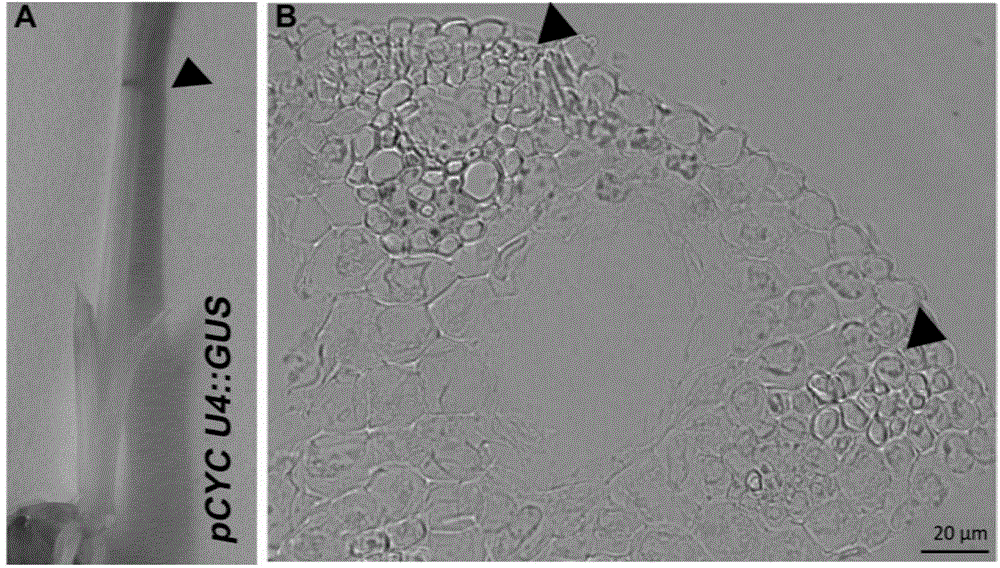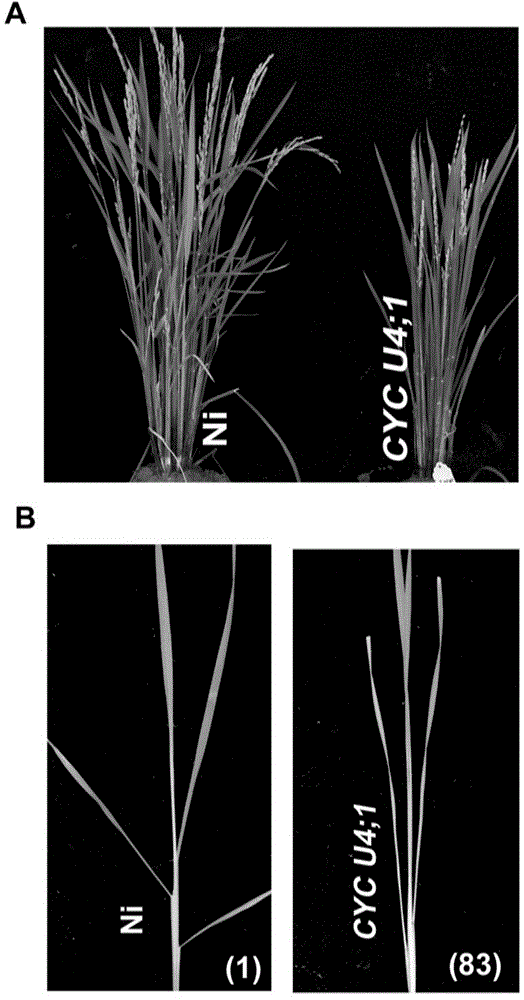Gene for controlling rice stem-leaf angle and application of gene
A gene and rice technology, applied in the fields of application, genetic engineering, plant genetic improvement, etc., can solve the problems of unclear cellular and molecular mechanisms
- Summary
- Abstract
- Description
- Claims
- Application Information
AI Technical Summary
Problems solved by technology
Method used
Image
Examples
Embodiment 1
[0031] Obtaining of a gene CYC U4;1 that controls the erect development of rice leaves:
[0032] The inventor constructed a gene-specific expression chip for rice leaves and leaf occiputs, and selected the gene CYC U4 specifically expressed at the leaf occipital from the differentially expressed genes of the chip by means of reverse genetics; 1, using real-time qRT- PCR verified the specificity of CYC U4;1 expression in the occipital region. details as follows:
[0033] A gene CYC U4;1, which controls the erect development of rice leaves, was obtained by the following method:
[0034] The total volume of the reaction system is 50μl, the template is Nipponbare cDNA 1ul (about 50ng), 10×KOD enzyme reaction buffer 5μl, 25mM MgCL 2 2μl, 5mM dNTP 5μl, 5uM primer 5μl (using stepwise PCR, the first use of primers CYCU4-U and CYCU4-L-1, the second use of primers CYCU4-U and CYCU4-L-2, each primer is 2.5μl), 1μl KOD enzyme, add ddH 2 O (sterile deionized water) to 50μl.
[0035] The reactio...
Embodiment 2
[0044] The application of CYC U4;1 gene in the control of rice leaf erection, the application process is as follows:
[0045] 1) Construction of plant expression vector pCYCU4; 1-GUS
[0046] Amplify the CYC U4; 1 promoter region, and clone the fragment into pCAMBIA1300GN GUS(Ren ZH,Gao JP,Li LG,et al.A rice quantitative trait locus for salt tolerance encodes a sodium transporter[] by using the HindIII / BamH1 restriction site J]. Nature genetics, 2005, 37(10): 1141-1146.).
[0047] The CYC U4; 1 promoter region is obtained in the following way:
[0048] The total volume of the reaction system is 50μl, the template is Nipponbare genomic DNA 1ul (about 50ng), 1×KOD enzyme reaction buffer 5μl, 25mM MgCL 2 2μl, 5mM dNTP 5μl, 5uM primer 5μl (primers pCYCU4-U and pCYCU4-L 2.5μl respectively), 1μl KOD enzyme, add ddH 2 O (sterile deionized water) to 50μl. The reaction procedure is: denaturation at 94°C for 5 min, 94°C for 30s, 55°C for 1 min, 68°C for 2 min, 35 cycles, and 68°C for extensio...
PUM
 Login to View More
Login to View More Abstract
Description
Claims
Application Information
 Login to View More
Login to View More - R&D
- Intellectual Property
- Life Sciences
- Materials
- Tech Scout
- Unparalleled Data Quality
- Higher Quality Content
- 60% Fewer Hallucinations
Browse by: Latest US Patents, China's latest patents, Technical Efficacy Thesaurus, Application Domain, Technology Topic, Popular Technical Reports.
© 2025 PatSnap. All rights reserved.Legal|Privacy policy|Modern Slavery Act Transparency Statement|Sitemap|About US| Contact US: help@patsnap.com



